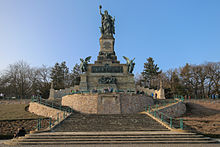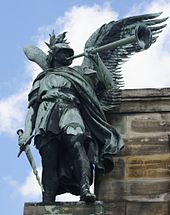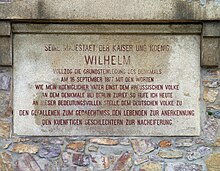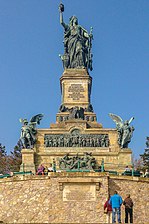Niederwald Monument
The Niederwald monument is located on the edge of the Niederwald landscape park above the town of Rüdesheim am Rhein . At its feet are the vineyards of the Rüdesheimer Berg .
The memorial was intended to commemorate the unification of Germany in 1871 . Planning and construction took a total of twelve years from the first suggestion in 1871 to the inauguration on September 28, 1883. The construction time was six years.
Together with the Barbarossadenkmal on the Kyffhäuserberg , the Deutsches Eck in Koblenz , the Hermannsdenkmal near Detmold in the southern Teutoburg Forest , the Kaiser Wilhelm monument at the Porta Westfalica , the Völkerschlachtdenkmal in Leipzig , the Bismarck monument in Hamburg and the Walhalla near Donaustauf includes the Niederwalddenkmal to the predominantly at the time of the German Empire resulting monumental memorial structures Germany.
The Niederwald monument has been part of the UNESCO World Heritage Upper Middle Rhine Valley since 2002 .
Occasion and planning
Historical background
The reason for the construction of the Niederwald monument was the Franco-German War in 1870/71 and the subsequent establishment of the German Empire on January 18, 1871. The latter was the result of decades of efforts to unite the many states of the German Confederation . In addition, it became generally fashionable in the 19th century in Germany to erect monuments to commemorate historical events or people. During the war of 1870/71, the first ideas for the erection of a national monument for this purpose arose. After the founding of the empire, suggestions were made from many sides.
Location question

The Rhine gained special attention as a location because it was an important symbol for the Germans. It has been an important scene of German history and the world of legends and fairy tales ( Rhine romanticism ) since ancient times . From the First Coalition War until the fall of Napoleon , it was a Franco-German border river for around twenty years.
Many German soldiers had sung the song Die Wacht am Rhein when they went to the war of 1870/1871. It was even considered as an anthem for the new German Empire. The annexation of Alsace-Lorraine completely displaced France from the left bank of the Rhine . The Rhine had become a purely German river - apart from its origin and its mouth.
planning
On April 13, 1871, the writer Ferdinand Hey'l suggested the specific location Niederwald near Rüdesheim am Rhein in the "Rheinischer Kurier" . This proposal was received with great enthusiasm by many. The Wiesbaden district president, Botho Graf zu Eulenburg, took care of the further planning and organization of the monument building. First of all, he obtained the approval of Kaiser Wilhelm I and Imperial Chancellor Otto von Bismarck for the project. Then he founded a committee in Berlin, which mainly consisted of members of the Reichstag . He himself chaired the executive committee of this committee.
In November 1871, the monument project began with the publication of the first appeal for donations to the people. The first competition for artists, architects and sculptors followed in February 1872 to find a suitable design. However, none of the models submitted were in the opinion of the committee good enough for a real implementation. Only after a second tender were the ideas of the sculptor Johannes Schilling convincing. He submitted his third and final draft in April 1874. The architecture and the terrace structures of the monument were worked out by the Dresden architect Karl Weißbach . The implementation of the project was made more difficult by the fact that not enough money could be collected through donations. Therefore, the Reichstag had to make a grant. Construction of the monument could begin after three years of preparation.
Construction, inauguration and assassination
On September 16, 1877, the laying of the foundation stone was celebrated with a big party, at which Kaiser Wilhelm I was also present. In 1883 the construction work was finished. At the inauguration ceremony on September 28, 1883, the emperor gave another speech, which was disrupted by a mishap. Because the gun operator of the howitzer misinterpreted her officer's gesture, they already fired a salute while the Kaiser was still speaking. The Rhine ships heard the agreed signal and fired several gun salutes. So that the last words were not lost, they were chiseled on the middle landing of the staircase around the monument plinth. At the inauguration ceremony, an attempt to assassinate Kaiser Wilhelm I by a group of anarchists around August Reinsdorf and Emil Küchler took place. But this attack failed.
Image program
The Niederwald monument has a total height of 38.18 meters and weighs 75 tons. The figure program of the monument consists of several different sculptures and reliefs .
The Germania
At the top stands the main character, the 12.5 meter high Germania , on a plinth in front of a throne in the “old German style” with eagle cheeks. This symbolizes the imperial throne. Although the monument as a whole was oriented towards the south, its head is turned slightly to the left, i.e. to the east. With that she looks into the Rheingau, towards Germany. With her right hand she holds up the imperial crown, wreathed with laurel. The left hand, on the other hand, embraces a lowered sword wrapped in laurel. The laurel was already worn by the emperors in ancient times in the shape of a wreath as a symbol of victory and as a sign of power and is often used as a triumphant symbol in the 19th century.
The head of Germania, on the other hand , is crowned with oak leaves, the German attribute , and her long hair blows in the wind. Her body is covered with a heavy, wrinkled robe, which is decorated with various ornaments and animals. Eagles, deer, ravens, dragons and swans can be found - animals that are common in German fairy tales and legends. An eagle frieze and a gemstone border are attached to the edge of the coat . To protect the Germania wearing a chest koller with embossed imperial eagle . It was supposed to unite everything that belonged to the image of Germany at that time.
The model for Germania was Schilling's younger daughter Clara.
The base
On the pedestal on which the Germania stands, in the south-southeast on the front of the monument, there is the inscription: "IN MEMORY OF THE UNIQUE VICTORIOUS UPRISING OF THE GERMAN PEOPLE AND THE RE ESTABLISHMENT OF THE GERMAN EMPIRE 1870–1871". The names of important battlefields from the war of 1870/71 are recorded on the right and left of the base; so on the west-north-west side one below the other: Weissenburg Woerth Spichern Courcelles Mars la Tour Gravelotte Beaumont Sedan. On the east-northeast side: Strasbourg Metz Le Bourget Amiens Orleans Le Mans St. Quentin Paris. In the north-northwest the commemorative inscription: Friede zu Frankfurt 10 May 1871 (with the date underneath).
On the chamfered edges of the upper plinth there are palm branches that were not actually intended and were only added after the foundation stone was laid. They serve to commemorate the fallen, since in Christianity they represent the symbol of martyrdom and, as an evergreen plant part, that of eternal life.
At the foot of the top pedestal are wreaths and the iron cross . They lead to a row of coats of arms, in the center of which sits the imperial eagle with the Prussian coat of arms on the chest. This is just about to rise. The series of coats of arms includes all coats of arms of the states of that time, on the front side the four kingdoms of Saxony , Prussia , Bavaria and Württemberg .
The main relief
In the main relief below the base, 133 life-size people are depicted. This makes it the largest bronze relief of the 19th century. King Wilhelm of Prussia sits on horseback in the center. The generals and princes of northern Germany gather around him on the right, and those from southern Germany on the left. Consequently, the relief shows the spirit of optimism before the Franco-Prussian War and not the situation after the establishment of the Empire. Under the federal flag and the flags of the largest cities in Germany are the people of Bismarck, Moltke , Prince Friedrich Karl , Crown Prince Albert of Saxony , Friedrich Franz II. Grand Duke of Mecklenburg-Schwerin , General Edwin von Manteuffel , a Prussian guardsman with a flag and a Saxon infantryman highlighted in full length with drum. They look into the distance with partly transfigured eyes and gather around their leader, King Wilhelm. On Wilhelm's left side are the Crown Prince Friedrich Wilhelm of Prussia , the generals von Blumenthal , von Hartmann , Ludwig von der Tann-Rathsamhausen , August von Werder , a Hessian hunter and a Prussian gunner. Anyone who had been involved in the war or at least had such members should be able to find themselves in a representative of the military branches. Therefore, under the figures, representations of the military leaders as well as the teams and troops can be made out.
The allegories
The allegories of war and peace were already part of Schilling's first draft of the monument and, together with the main character of Germania, form a triad. They are also larger than life, but smaller than the Germania and flank the main relief.
On the left side of the relief is the allegory of war. He is depicted as a winged genius blowing a trumpet and holding a lowered sword in his right hand. He wears a helmet and armor in the Gothic style. The lowered sword indicates the victorious end of the battle. Schilling deliberately placed the allegory of war in the direction of France, just as he placed the allegory of peace on the other side of the main relief to the east, i.e. towards Germany. Peace is represented as an angel with an olive branch and a cornucopia . The olive branch is an ancient symbol for peace, while the cornucopia stands for the prosperity and happiness made possible by peace.
The side reliefs
Behind the allegory of war is the side relief "Farewell of the warriors". In this relief relief, countrymen and soldiers from the north, from Bavaria, people of various age groups and family positions are depicted in sections. In the case of the figures, pain and not joy seem to predominate. On the other side of the main relief, behind the allegory of peace, is the homecoming relief. It is not divided into scenes, but represents a uniform space for all returnees from the Franco-Prussian War. Here joy prevails, oak leaves adorn the picture.
The song Die Wacht am Rhein
Five of the six stanzas of the song Die Wacht am Rhein are carved under the main relief . For parts of society at that time it had a kind of hymn-like character, especially for the German soldiers in 1870. Max Schneckenburger had composed the song and in 1854 it was set to music by Carl Wilhelm . According to their content, the stanzas were chiseled under the relief at the right place. For example, under King Wilhelm, who holds his hand to his chest on his horse and gazes transfigured into the sky: “He looks up into Heaven, where heroic fathers look down, and swears with proud belligerence; you Rhine stay German like my breast! ”In addition to preservation, the melody is engraved on a boundary stone. The stanza that refers directly to France has been left out.
Father Rhine and daughter Mosel
The lowest element of the monument is a bronze group below the main relief: Father Rhine hands over the guard's horn to his daughter, the Moselle. This indicated the border shift achieved during the war, i.e. that the Rhine was no longer a border river, since Alsace and Lorraine were now also part of the German Empire.
The axes
Last but not least, the special arrangement of the individual elements in the Niederwald monument should be mentioned. The horizontal stripe of the ornaments shows the sequence of events. First the soldiers from all regions of the small-state Germany set out, the war began represented by the allegory of war. The generals of southern Germany indicate the beginning of the fight and overall everyone gathered around King Wilhelm of Prussia, with the northern German generals on his left symbolizing the victorious course of the war. This is followed by peace, indicated by the allegory, and finally the warriors return home to the unified German Empire. The vertical axis, on the other hand, presents the results of the war. Germania holds the crown symbolically for the new sovereign prince, the main inscription praises the "reestablishment of the German Empire", the imperial eagle and the coat of arms of the German states symbolize German unity as well as the union of all princes with the Prussian king and, finally, the expansion of the border from Rhine to Moselle.
Tourist importance
The patriotic monument has attracted many tourists since its inauguration. It became more and more a popular destination rather than a site for patriotic memorial services. From 1885 the Niederwaldbahn ran from Rüdesheim up to the Niederwald , but it was partially destroyed in an air raid in 1944 and later dismantled. Instead, the Rüdesheim cable car has been leading to the monument high above the city since 1954 .
Today the monument is looked after by the administration of the State Palaces and Gardens of Hesse . From April to the beginning of September 2008, the area surrounding the monument was renovated for 1.5 million euros. In the summer of 2011, work began on the extensive restoration of the sculptures, reliefs and the sandstone plinth, which lasted around a year.
The Rheinsteig , the new hiking trail from Wiesbaden ( Biebrich Castle ) to Bonn via Liebenstein Castle and Lahneck Castle , leads past the Niederwald Monument.
125th anniversary
The city of Rüdesheim celebrated the anniversary of the monument with a three-day festival program from September 26th to 28th, 2008. The "old lady" visited the city in the form of a five-meter high painting by the Rheingau artist Michael Apitz. Guests at the celebration at the monument itself on the evening of September 27, 2008 included the Hessian Prime Minister Roland Koch and the Federal Minister of Defense, Franz Josef Jung . Ina Schilling-Nickel, great-granddaughter of the builder, also came, as did representatives of the Schilling Museum in Mittweida with museum director Heiko Weber. An exhibition on the construction time and inauguration 125 years ago was on view in the town hall. The historic lecture in the town hall was given by the Mainz historian Ralph Erbar.
reception
The Cologne chocolate producer Ludwig Stollwerck had a "chocolate temple" built for the World's Columbian Exposition in Chicago in 1893, which showed a 12 m high replica of the Germania of the Niederwald monument made from 300 kg of chocolate.
photos
literature
- Reinhard Alings: Monument and Nation. The image of the nation state in the monument medium. On the relationship between nation and state in the German Empire, 1871–1918 . Walter de Gruyter, Berlin 1996. ISBN 3-11-014985-0
- Bettina Brandt: Border guards and brothers. Representations of nation, gender and politics in pictures of Germania, Vol. 1 (representations), Bielefeld 2005, pp. 451–458.
- Ralph Erbar: Germany - united fatherland? The Niederwald monument near Rüdesheim as an expression of nationalism in the German Empire. In: Geschichte für heute 1/2009, pp. 20–35 (with additional literature)
- Ralph Erbar: The Watch on the Rhine. The Niederwald monument near Rüdesheim. Nation and nationalism in Germany. In: Bernd Heidenreich, Klaus Böhme (Ed.): Hessen. History and politics . Stuttgart, Berlin, Cologne 2000, pp. 316–327 (= writings on the political geography of Hesse, vol. 5)
- Ralph Erbar: The watch on the Rhine stands firm and true! (National) monuments in the classroom using the example of the Niederwald monument. In: Practice History. 6/2003 (Denk-Mal), pp. 16-20
- Friedrich Rudolf Engelhardt: The Niederwald monument . Bingen 1973.
- Gerhard Honekamp: The Niederwald Monument - a modern pilgrimage site. In: Everyday life between the mighty and the idlers - historical explorations in Wiesbaden and the surrounding area. Breuer, Wiesbaden-Erbenheim 1995, pp. 158-162.
- Josef Schrattenholz : The National Monument on the Niederwald . Orell Füssli, Zurich 1884. (= European Wanderbilder 83)
- Lutz Tittel: The Niederwald Monument 1871–1883, Hildesheim 1979.
- Lutz Tittel: The Niederwald monument near Rüdesheim am Rhein . Verlag Robert Gessler, Friedrichshafen 1985, ISBN 3-922137-30-X (monument guide ).
Web links
- Everything to do with the Niederwald Monument
- Germania - National Monument on the Niederwald: Bookmark from 1880
- Aerial photo on Panoramio.com
- The Niederwald monument in the Doorn Castle photo collection
- Esther-Beatrice von Bruchhausen, The sign in the costume ball - Marianne and Germania in the political iconography Diss. Halle 2000. Chapter 7: The history of the origins of the Niederwald monument, pp. 185-252.
- Interactive 360 ° all-round view of the Niederwald Monument
Individual evidence
- ↑ Burckhardt Helferich: Hantzsch, Arthur. In: New German Biography (NDB). Volume 7, Duncker & Humblot, Berlin 1966, ISBN 3-428-00188-5 , p. 641 f. ( Digitized version ).
- ↑ Antje Laumann-Kleineberg: Monuments of the 19th century in conflict. Three case studies for discussion between clients, planners and public critics. Frankfurt am Main 1989, p. 49 f.
- ^ ASS-Verlag of October 2, 2008: 125 Years of the Niederwald Monument ( Memento of October 24, 2011 in the Internet Archive )
Coordinates: 49 ° 58 ′ 51.7 " N , 7 ° 53 ′ 59.4" E
















